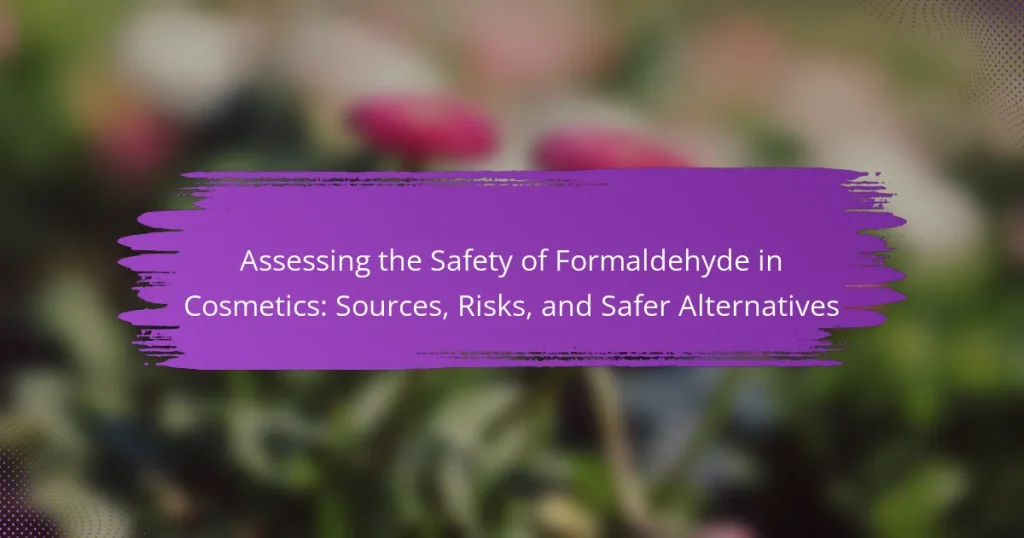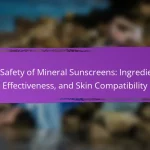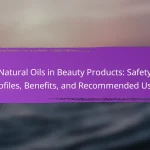Formaldehyde is a colorless gas widely utilized as a preservative in cosmetics, primarily for its antimicrobial properties that inhibit bacterial and fungal growth, thus prolonging product shelf life. However, its use raises significant health concerns, as formaldehyde can cause skin irritation, allergic reactions, and is classified as a probable human carcinogen linked to serious conditions such as nasopharyngeal cancer. Many countries regulate formaldehyde levels in cosmetics to mitigate these risks. As a result, manufacturers are increasingly turning to safer alternatives like phenoxyethanol, ethylhexylglycerin, and benzyl alcohol, which have been recognized for their effectiveness and safety in cosmetic formulations. This article assesses the safety of formaldehyde in cosmetics, exploring its sources, associated risks, and the viability of safer substitutes.
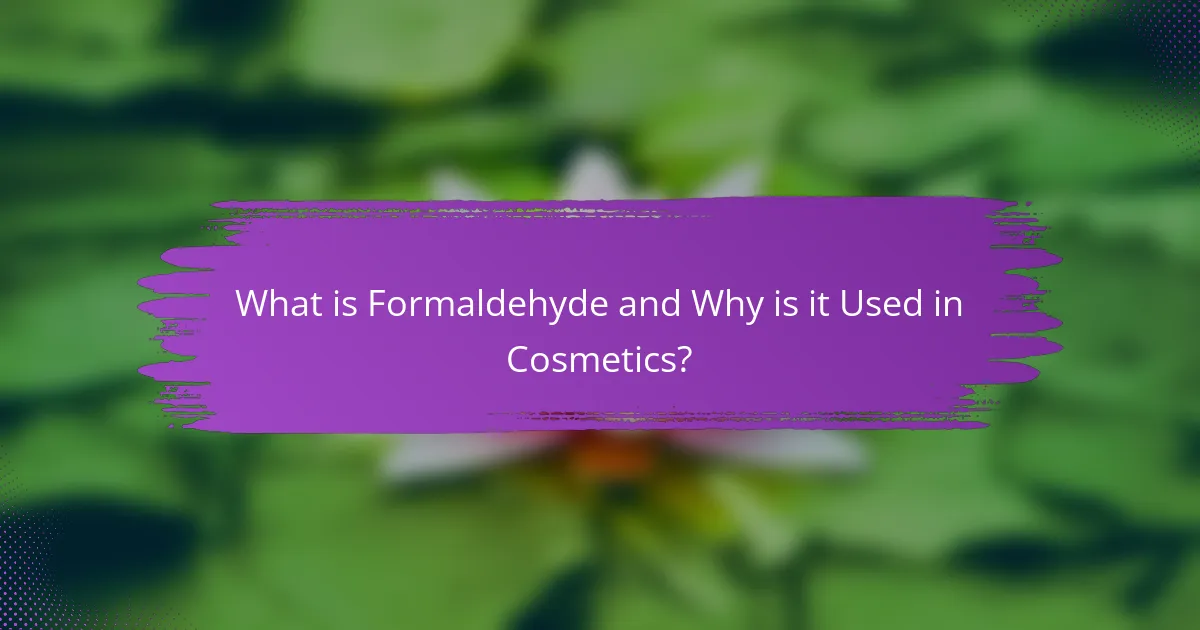
What is Formaldehyde and Why is it Used in Cosmetics?
Formaldehyde is a colorless gas commonly used as a preservative in cosmetics. It serves as an antimicrobial agent, preventing the growth of bacteria and fungi. This property helps extend the shelf life of various cosmetic products. Formaldehyde is often found in products like nail polish, hair straightening treatments, and some skincare items. The use of formaldehyde in cosmetics is regulated in many countries due to safety concerns. Studies indicate that formaldehyde can cause skin irritation and allergic reactions in some individuals. Additionally, long-term exposure is linked to more serious health risks. Therefore, manufacturers often seek safer alternatives to formaldehyde in cosmetic formulations.
How does Formaldehyde function as a cosmetic ingredient?
Formaldehyde functions as a cosmetic ingredient primarily as a preservative. It helps prevent the growth of bacteria, fungi, and other microorganisms in cosmetic products. This antimicrobial property extends the shelf life of products. Formaldehyde is also used in some hair treatments to provide straightening effects. It works by cross-linking proteins in the hair, resulting in a smoother texture. The use of formaldehyde in cosmetics is regulated due to safety concerns. Studies have shown that exposure to formaldehyde can cause skin irritation and allergic reactions. The Cosmetic Ingredient Review (CIR) has assessed its safety, establishing acceptable concentration levels for use in cosmetics.
What are the specific roles of Formaldehyde in cosmetic formulations?
Formaldehyde serves multiple roles in cosmetic formulations. It acts primarily as a preservative, preventing microbial growth and extending shelf life. Additionally, it functions as a fixative, helping to stabilize fragrances in products. Formaldehyde also acts as a bonding agent in hair straightening treatments. Its antimicrobial properties contribute to the overall safety of cosmetic products. Regulatory bodies, such as the FDA, recognize its use within specific concentration limits. Studies have shown its efficacy in preserving product integrity while ensuring consumer safety. Proper formulation and adherence to guidelines mitigate potential risks associated with its use.
How does the concentration of Formaldehyde affect its use in cosmetics?
The concentration of formaldehyde significantly affects its use in cosmetics. Higher concentrations can lead to increased irritation and allergic reactions in users. Regulatory bodies, such as the FDA, limit formaldehyde levels in cosmetic products to ensure safety. For instance, the FDA allows a maximum concentration of 0.2% in cosmetics. This limit aims to minimize potential health risks. Additionally, formaldehyde is classified as a human carcinogen at certain exposure levels. Thus, lower concentrations are preferred to mitigate these risks while maintaining product efficacy.
What types of cosmetics commonly contain Formaldehyde?
Cosmetics that commonly contain formaldehyde include nail polish, hair straightening products, and some skin creams. Nail polish often uses formaldehyde as a hardening agent. Hair straightening products may contain formaldehyde or its releasers for smoothing effects. Some skin creams utilize formaldehyde as a preservative to prevent microbial growth. The presence of formaldehyde in these products raises safety concerns due to its potential health risks. Studies have linked formaldehyde exposure to skin irritation and allergic reactions. Regulatory agencies monitor these cosmetics to ensure consumer safety.
Which personal care products are most likely to include Formaldehyde?
Personal care products most likely to include formaldehyde are hair straightening treatments, nail polishes, and some skin care products. Hair straightening treatments often contain formaldehyde or formaldehyde-releasing ingredients for effective results. Nail polishes may include formaldehyde as a hardening agent. Some skin care products, especially those with preservatives, can also contain formaldehyde or its derivatives. These products are commonly used in salons and at home. The presence of formaldehyde is often due to its effectiveness as a preservative and antimicrobial agent. Safety regulations vary by region, impacting the formulation of these products.
Are there specific brands known for using Formaldehyde in their products?
Certain brands are known for using formaldehyde in their products. Notable examples include some hair straightening products from brands like Brazilian Blowout and Keratin Complex. These products have been reported to contain formaldehyde or formaldehyde-releasing preservatives. Regulatory agencies have raised concerns about the safety of these ingredients in cosmetics. Studies have indicated potential health risks associated with formaldehyde exposure. Consumers are advised to check ingredient labels for formaldehyde and its derivatives.
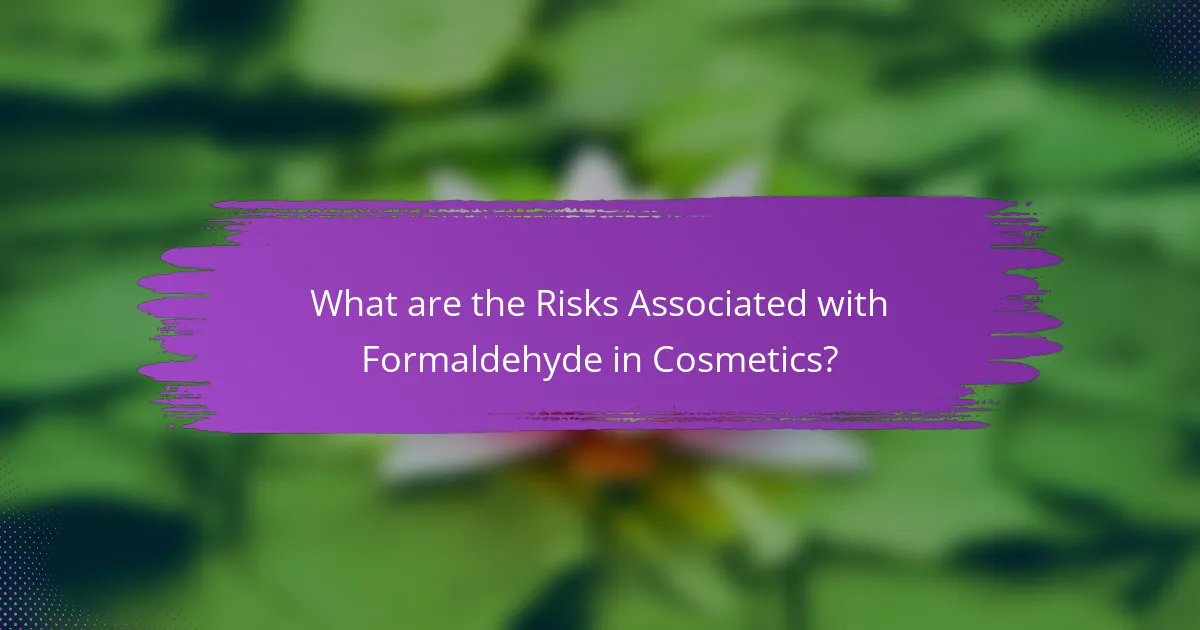
What are the Risks Associated with Formaldehyde in Cosmetics?
Formaldehyde in cosmetics poses several health risks. It is a known irritant that can cause skin reactions, including dermatitis. Prolonged exposure may lead to respiratory issues, such as asthma. Formaldehyde is also classified as a probable human carcinogen by the International Agency for Research on Cancer. This classification is based on evidence linking formaldehyde exposure to nasopharyngeal cancer. Additionally, it can cause eye irritation and allergic reactions in sensitive individuals. The presence of formaldehyde in products can lead to consumer concerns about long-term health effects. Regulations limit its concentration in cosmetics, but risks remain, especially with improper use.
What health risks are linked to Formaldehyde exposure through cosmetics?
Formaldehyde exposure through cosmetics is linked to several health risks. It can cause skin irritation and allergic reactions in sensitive individuals. Prolonged exposure may lead to respiratory issues, such as asthma or chronic bronchitis. Formaldehyde is also classified as a human carcinogen, increasing the risk of cancer with long-term exposure. Studies show that formaldehyde can disrupt hormonal functions, leading to reproductive health concerns. Additionally, it may contribute to developmental issues in children when pregnant women are exposed. The FDA and various health organizations have raised concerns about these risks, urging consumers to be cautious with products containing formaldehyde.
How does Formaldehyde affect skin sensitivity and allergic reactions?
Formaldehyde can increase skin sensitivity and trigger allergic reactions. It acts as a skin irritant, leading to contact dermatitis in sensitive individuals. Studies indicate that exposure can result in symptoms like redness, itching, and swelling. The American Contact Dermatitis Society recognizes formaldehyde as a common allergen. Research shows that approximately 2-5% of the population may have a formaldehyde allergy. Prolonged exposure can exacerbate these reactions, especially in cosmetic products. Products containing formaldehyde-releasing preservatives are often implicated in these sensitivities.
What long-term health effects have been studied regarding Formaldehyde in cosmetics?
Long-term health effects studied regarding formaldehyde in cosmetics include respiratory issues and skin irritation. Prolonged exposure can lead to allergic reactions and dermatitis. Research indicates a potential link between formaldehyde and cancer, particularly nasopharyngeal cancer. The International Agency for Research on Cancer classifies formaldehyde as a human carcinogen. Studies show that individuals exposed to formaldehyde in cosmetics may experience chronic health problems. The cosmetic industry has faced scrutiny due to these findings. Regulatory bodies have established guidelines to limit formaldehyde levels in products. This reflects ongoing concerns about consumer safety and health impacts.
How are regulatory agencies addressing the safety of Formaldehyde in cosmetics?
Regulatory agencies are addressing the safety of formaldehyde in cosmetics by establishing guidelines and limits for its use. The U.S. Food and Drug Administration (FDA) monitors cosmetic products for safety. The FDA has identified formaldehyde as a potential carcinogen. The agency recommends that cosmetics containing formaldehyde should not exceed 0.2% in leave-on products. The European Commission has stricter regulations, banning formaldehyde in cosmetics since 2012. Studies show that exposure to formaldehyde can cause skin irritation and allergic reactions. Regulatory agencies continuously review safety data to ensure consumer protection. They also encourage manufacturers to seek safer alternatives to formaldehyde in cosmetic formulations.
What guidelines do organizations like the FDA and EU provide regarding Formaldehyde?
The FDA and EU provide specific guidelines regarding formaldehyde in cosmetics. The FDA does not have a specific limit but advises that formaldehyde should not be used in products in a manner that poses a risk to consumers. The EU, through its Cosmetics Regulation (EC) No. 1223/2009, restricts formaldehyde in cosmetic products to a maximum concentration of 0.2% in leave-on products and 0.5% in rinse-off products. Both organizations recommend safety assessments to evaluate the potential risks associated with formaldehyde exposure. The EU also mandates labeling for products containing formaldehyde to inform consumers. These guidelines aim to minimize health risks while ensuring consumer safety.
How do safety assessments evaluate the risks of Formaldehyde in cosmetic products?
Safety assessments evaluate the risks of Formaldehyde in cosmetic products through toxicological studies and exposure assessments. These evaluations include analyzing the concentration of Formaldehyde in formulations. They also assess potential health effects, such as skin irritation and sensitization. Regulatory agencies, like the FDA and EU, set safety limits for Formaldehyde levels. Risk assessments consider both short-term and long-term exposure scenarios. Data from clinical trials and epidemiological studies support these evaluations. The overall goal is to determine if the product is safe for consumer use.
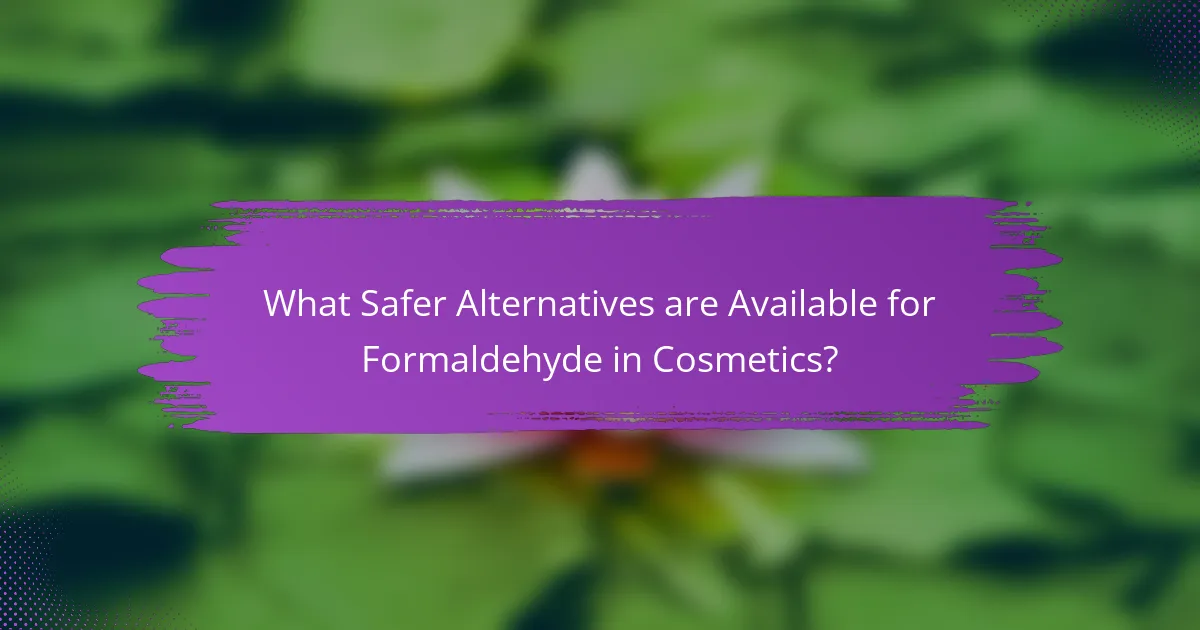
What Safer Alternatives are Available for Formaldehyde in Cosmetics?
Safer alternatives to formaldehyde in cosmetics include phenoxyethanol, ethylhexylglycerin, and benzyl alcohol. Phenoxyethanol is a widely used preservative that effectively prevents microbial growth. Ethylhexylglycerin serves as both a preservative and skin-conditioning agent. Benzyl alcohol is a naturally occurring compound that acts as a preservative and solvent. These alternatives have been evaluated for safety and are commonly accepted in cosmetic formulations. The European Commission and the Cosmetic Ingredient Review have recognized these alternatives as safe for use in cosmetics.
What are some common alternatives to Formaldehyde in cosmetic formulations?
Common alternatives to formaldehyde in cosmetic formulations include phenoxyethanol, ethylhexylglycerin, and benzyl alcohol. Phenoxyethanol is widely used as a preservative and has a good safety profile. Ethylhexylglycerin acts as both a preservative and skin-conditioning agent. Benzyl alcohol serves as a solvent and preservative, effective against bacteria and fungi. These alternatives provide similar antimicrobial properties without the associated risks of formaldehyde.
How effective are these alternatives compared to Formaldehyde?
Alternatives to formaldehyde are generally effective but vary in performance. Some alternatives, like phenoxyethanol, provide antimicrobial properties similar to formaldehyde. Others, such as natural preservatives, may not offer the same broad-spectrum efficacy. Research indicates that while some alternatives can match formaldehyde’s effectiveness, they may require higher concentrations. For instance, a study published in the Journal of Cosmetic Science found that certain natural preservatives were less effective against specific bacteria compared to formaldehyde. Overall, the effectiveness of alternatives depends on the specific application and formulation.
What benefits do safer alternatives offer to consumers?
Safer alternatives offer consumers reduced health risks associated with harmful chemicals. These alternatives often contain natural or less toxic ingredients. This leads to fewer allergic reactions and skin irritations. Studies indicate that consumers report higher satisfaction with products free from harmful substances. Additionally, safer alternatives contribute to environmental sustainability. Products with safer formulations often have a lower ecological impact. This aligns with consumer preferences for eco-friendly choices. Overall, safer alternatives enhance consumer confidence in product safety and effectiveness.
What should consumers look for when choosing Formaldehyde-free cosmetics?
Consumers should look for certifications and ingredient transparency when choosing Formaldehyde-free cosmetics. Certifications from reputable organizations indicate compliance with safety standards. Ingredient lists should be clear and free from formaldehyde and its derivatives, such as formalin or methylene glycol. Additionally, consumers should seek products labeled as “formaldehyde-free” to ensure safety. Research shows that exposure to formaldehyde can cause skin irritation and allergic reactions. Therefore, selecting products that disclose their formulation enhances consumer safety.
How can consumers identify products that do not contain Formaldehyde?
Consumers can identify products that do not contain formaldehyde by checking ingredient labels. Many products list formaldehyde or its derivatives explicitly. Look for terms like “formaldehyde,” “formalin,” or “methanal.” Additionally, consumers can seek products labeled as “formaldehyde-free.” Certifications from credible organizations can also indicate safety. Research shows that awareness of ingredient transparency is increasing among consumers. A 2020 survey revealed that 70% of consumers read labels for harmful chemicals. This trend supports the demand for safer cosmetic alternatives.
What certifications or labels indicate safer cosmetic options?
Certifications and labels that indicate safer cosmetic options include the USDA Organic seal, the EWG Verified mark, and the Leaping Bunny logo. The USDA Organic seal ensures that products meet strict organic farming standards. The EWG Verified mark signifies that a product has been evaluated for safety and transparency by the Environmental Working Group. The Leaping Bunny logo indicates that no animal testing was involved in the product’s development. These certifications help consumers identify products that prioritize safety and ethical practices.
What practical tips can help consumers avoid Formaldehyde in cosmetics?
To avoid formaldehyde in cosmetics, consumers should read ingredient labels carefully. Look for terms like “formaldehyde,” “formalin,” or “methanol.” Choose products labeled as “formaldehyde-free.” Opt for brands known for safe formulations. Research product reviews and safety ratings. Avoid products with preservatives such as quaternium-15 or DMDM hydantoin, as they can release formaldehyde. Purchase from reputable retailers that prioritize safety. Stay informed about regulations and safety recalls related to cosmetics.
The main entity of this article is formaldehyde, a colorless gas used as a preservative in cosmetics. The article examines the various roles of formaldehyde in cosmetic formulations, its associated health risks, and the regulatory measures in place to ensure consumer safety. It highlights the specific types of cosmetics that commonly contain formaldehyde, the potential for skin irritation and allergic reactions, and the long-term health effects linked to exposure. Additionally, the article discusses safer alternatives to formaldehyde and provides practical tips for consumers to identify and avoid products containing this harmful ingredient.
